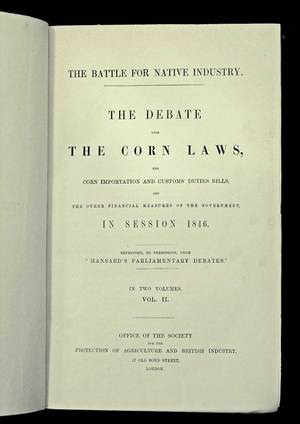Did you know that the recent horsemeat scandal was a result of the wet summer of 1845? Well, there is a link but you may find it rather tenuous.
The weather in the summer of 1845 was awful; cold and extremely wet. It all sounds horribly familiar. Not only was the weather bad in Britain but also in the rest of Northern Europe, which at that time was our main trading area for food. The Irish had their potato famine caused by blight and there were general food shortages across Europe. In Britain, the high price of food led to the repeal of the Corn Laws in 1846 and eventually opened us up to inter-continental competition.
The Corn Laws, in various forms, had been in place for centuries. The aim was to regulate movements of wheat to avoid the huge price volatility that occurred between seasons of plenty and seasons of shortage. They changed over time to adjust for improving transport systems between various parts of Britain and with Northern Europe and at one stage included storage of grain in years of plenty. So intervention stores are an old idea!
The Corn Laws were also open to abuse, and monarchs and parliaments tried to use them to raise money to fund their wars. From 1815 onwards they were used mainly to protect British agriculture by means of import duties. There was support for this, even from the free marketeers of the time, who thought it inconceivable that we should not be self-reliant in food production. However, the Government had to repeal them after the food shortages and high prices of 1845. As was reported at the time - “the rain rained away the Corn Laws”.
Their repeal did not have an immediate negative impact on British agriculture. A rapidly expanding non-rural population meant that prices remained relatively high and the age of science began to impact on production, particularly the use of fertilisers and machinery. In addition, the ability to mass-produce drainage tiles resulted in an enormous investment in land drainage. Between 1850 and 1880 the banks lent British farmers £12 million for land drainage, worth about £12 billion in today’s money.
However, some of the technology that aided this ‘Golden Age’ of farming presented new challenges. Steam power, which was beginning to help us to till the land, was also used in opening up the prairies. Perhaps more importantly, it resulted in faster, more efficient and more economic transport. The opening up of the prairies coupled with better transport systems resulted in a huge increase in cheap imports of wheat from the late 1870s onwards. In Britain during the 1880s wheat imports doubled and prices halved. Our high cost systems that were dependent on fertilisers to maintain fertility could not compete with large-scale farming that relied on the residual fertility from ploughing out the prairies. The so-called ‘Golden Age of English Farming’ was over and prices remained depressed until the First World War.
It was not only ‘corn’ that was down; ‘horn’ also suffered from competition. What prompted me to write this blog was that I read in The Times the other day that the first refrigerated cargo of lamb left New Zealand on the 15th February 1882, arriving in London on the 24th May. Up until then the New Zealand sheep industry had a problem. After years of building up stock and achieving self-sufficiency their isolation meant that they had no real means to exploit their potential for lamb production. They had tried canning lamb but this was not a success. However, refrigerated steam ships provided them with an opportunity, which they took with both hands.
So, it can be argued that the wet summer of 1845 resulted in Northern European countries finally accepting that their burgeoning populations could not be fed from their own resources. In the UK the protection offered by the Corn Laws was dropped and the large scale inter-continental food trade started. And you know what that meant; complicated food chains that are obviously open to abuse. I rest my case!
